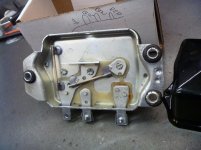- Joined
- Aug 19, 2007
- Messages
- 2,723
- Location
- Oregon Ohio
- Corvette
- 2015 Z06 Callaway White, 1967 Corvette RestoRod
The temperature gauge on my 1959 Corvette goes from 0 deg to 220 (full) in 30 to 40 seconds.
I changed the thermostat and checked for correct operation in a pot of boiling water.
I put in a new water temperature sensor on the intake manifold.
I used a handheld temperature sensing gun on different areas of the engine. Never got above 170 on the radiator, 160 at the radiator hoses or 140 at the thermostat housing or the water temp sensor.
I disconnected the wire from the water temp sensor and the gauge goes to zero.
Do I have a ground problem? :confused
Roger
I changed the thermostat and checked for correct operation in a pot of boiling water.
I put in a new water temperature sensor on the intake manifold.
I used a handheld temperature sensing gun on different areas of the engine. Never got above 170 on the radiator, 160 at the radiator hoses or 140 at the thermostat housing or the water temp sensor.
I disconnected the wire from the water temp sensor and the gauge goes to zero.
Do I have a ground problem? :confused
Roger









